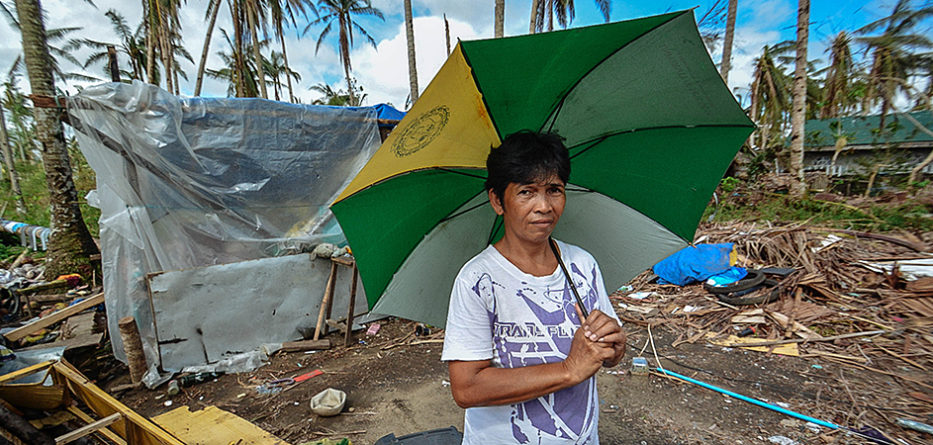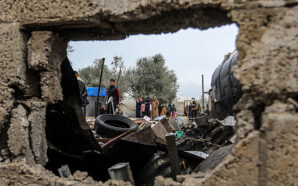After the Pastoral Guidelines for Refugees (2013) and those for Internally Displaced Persons (2020), it is the turn of a new document, a tool for awareness and action, Pastoral Orientations on Climate Displaced People.[1] As Pope Francis recalled on the occasion of Earth Day, April 22, 2021, “the things that we have been saying to one another must not fall into oblivion. […] Time is pressing and, as COVID-19 has taught us, yes, we have the means to rise up to the challenge. We have the means. It is time to act, we are at the limit.”[2] But first we must see, and in this Pastoral Orientations on Climate Displaced People helps us. The alternative, as the pontiff reminds us in the preface to the document, lies in “to see or not to see”: it all begins with our view of reality, “mine and yours.”
First of all, we must acknowledge that there is an ongoing climate crisis. In fact, although scientists have been sounding the alarm for over 40 years since the first World Climate Change Conference in Geneva in 1979 (and periodically renewing this heartfelt appeal: Rio 1992; Kyoto 1997; Paris 2015), there is still a long way to go to address climate change effectively. It is necessary to see the human face of this crisis, that is, to understand that it has both an immediate or long-term impact on people, and often on the most vulnerable. Moreover, it is necessary to see in order to understand that the climate crisis also has links with displacement: many people, because of it, are on the move. We read in a recent report published for Earth Day 2021 by the United Nations High Commissioner for Refugees (UNHCR): “The climate emergency is the major crisis of our time and displacement is one of its most devastating consequences. Whole populations are already suffering the consequences, but vulnerable people living in some of the most fragile and conflict-affected countries are disproportionately affected.”[3]
Who are the climate displaced?
Climate Displaced People (CDPs from now on, as they are called in the document), also called climate migrants, environmental refugees, or eco-refugees, are people or groups of people forced to leave their usual place of residence because of a climate crisis (UNHCR recommends the expression “people displaced in the context of disasters and climate change”). Technically they are not a category identified by the 1951 Geneva Convention on the recognition of refugee status. The Convention considers a refugee to be a person who crosses an international border due to a well-founded fear of persecution on account of race, religion, nationality, membership of a particular social group or political opinion. Therefore, CDPs are not always considered a vulnerable group. However, according to the UNHCR, “despite not being an officially recognised expression, many of those we call ‘climate refugees’ are entitled to the forms of protection recognised by the international community.”[4] Legislation – both national and international – is also beginning to go beyond a single perspective.[5]
Today, migration flows are often mixed, with women, children and men travelling for different reasons: economic inequality, conflict, violence, loss of rights and climate change. They find themselves side by side in desperate journeys, sometimes in the same boat. In many circumstances, these different reasons reside simultaneously in the same person, or in the same household, in more or less explicit ways. For example, the climate crisis is one of the reasons that leads to displacement, because it involves the depletion of natural resources with a consequent impoverishment of the population, and on many occasions triggers conflicts or aggravates ones that already exist. If one takes into account the environmental component of migration, it is estimated that by 2050 the number of CDPs could reach about 143 million.[6]
The document notes that “displacement can take place either due to rapid-onset triggers, mainly extreme weather phenomena like floods, storms, droughts and wildfires; or slow-onset processes, like desertification, depletion of natural resources, water scarcity, rising temperatures and sea-level rise.”
The impact of the crisis, as often happens, dramatically affects the most vulnerable, such as children, women and people with disabilities who do not even have the possibility of moving from the places where most risk is involved, so much so that the expression “trapped populations” has been coined for them.[7] These are people who would not be able to migrate because of their vulnerable situation, even if they wanted or needed to. It is precisely because of the care of these people that this pastoral document, which is based on the reflections and teaching of the Catholic Church and nourished by various types of experience in this field, finds its raison d’être.
The document lists nine points corresponding to as many challenges, for which nine articulated responses are proposed on various levels of action and intervention. For the sake of simplicity, we will proceed by grouping together some aspects, emphasising only some of these points and leaving the seventh point, which concerns the provision of pastoral care, to last.
Raising awareness and opening eyes
In order to be able to open our eyes to the climate crisis, to the consequences for people and to the connection with their displacement, one of the main challenges to overcome is that of the false polarisation, which places “care for creation” on one side and “development and economy” on the other. In fact, as the encyclical Laudato Si’ (LS) reminds us, “the human environment and the natural environment degrade together” (LS 48). Therefore, integral human development – and consequently the fight against poverty – and sustainable development must go hand in hand. The lifestyles of each of us have often been guided (and still are) by economic models that not only create inequality (human degradation), but create it through the exploitation of the common home (environmental degradation). Economics and ecology have more than a common root – oikos (“home”) – and are closely connected. “It is contemporary lifestyles that have demanded and supported […] short-sighted national-interest and market-driven goals, under the pretext of so-called ‘socio-economic development.’ We human beings have become the most harmful ‘omnivorous predators’ on the Planet.”[8]
It is therefore necessary that each one of us be more aware of the realities (point 2: Promoting Awareness and Recognition) of the climate crisis and displacement through an awareness of this interdependence, and that this recognition results in a change of personal lifestyles, a real ecological conversion. It is necessary that young people be promoters of this change, and that local communities, especially indigenous communities, be promoters as well, so that awareness-raising is concrete and not abstract.
Alternatives or accompanying the displaced
Once eyes are opened to the climate crisis, possible alternatives to displacement must be analysed (point 3: Providing Alternatives to Displacement) and, if this is not feasible, people must be prepared for and accompanied in displacement (point 4: Preparing People for Displacement).
Leaving home, abandoning everything to seek security and sustenance elsewhere is one of the most difficult decisions to make; therefore, it is a decision made under compulsion, to be taken only in the absence of possible alternatives. It usually occurs when one is fully aware of the fact that survival in your homeland is not – or soon will not be – possible anymore. “The Catholic Church is called to enhance the resilience of people affected by the climate crisis and to assist in the search for alternatives to displacement” that can uphold the right to life, and to a life of dignity.
Accompanying the creation of this “climate resilience” is then a key step. Again, “timely, robust and reliable” information is essential. In-situ adaptation to climate change must also be promoted, infrastructures must be built that are compatible with it, and alternative ecological programs must be created.
But when all this is not possible, people and groups must be accompanied in their displacement. Often, in fact, those who leave, and do not do so by free choice, find themselves without a migration goal. Accompaniment also makes it necessary to map out in advance the areas where the relocation of these people can be carried out. It is also important to produce social maps, i.e., a picture of the potential human resources of those who are displaced and, at the same time, of the population of the place of relocation.
Inclusive and integrated community development
Managing the migration issue is not just about organising flows. “Ensuring effective integration and inclusion of migrants in the EU is a social and economic investment that makes European societies more cohesive, resilient and prosperous.”[9] This passage from the EU Integration and Inclusion Plan 2021-2027 highlights the awareness, now taken up at the level of national governments and supranational and international institutions, of the necessity of these processes for the migrant population: not only for those recently arrived, but also for those with a migration background, with a priority for minors and the most vulnerable.
Inclusion (understood not as a set of projects conceived for a particular category of people) and integration (understood not as insertion into already acquired cultural paths) are also fundamental for the CDPs (point 5: Fostering Inclusion and Integration). Inclusion and integration should be considered as two-way reciprocal processes, gradual, accompanying and taking charge of each other, citizens and migrants. No group should feel like a minority, and live accordingly, but everyone should be able to enjoy full citizenship in their diversity, which can contribute to the construction of a community of life in which social friendship reigns.[10] These paths require a “multi-level governance,”[11] that is, coordinated and combined action between the various actors involved: institutional and civil society. In this regard, the role of the Church “which is called to engage society and to prepare and encourage people to be welcoming” is very important.
Influence decision-making processes and cooperate in strategic ones
Several times in the document the need for active participation of climate displaced persons in decision-making processes is recalled (point 6: Exercising a Positive Influence on Policy-Making). In this perspective, a central passage is where the role of the Church in being a guarantor of the place of the weakest is emphasised, so that their voices are heard and taken into account. “Any plan, policy or strategy that does not recognise the wisdom that comes from the ‘poor’ ignores the wisdom of the Spirit present in them and will most likely fail.” Increasingly, decisions are made by a few, driven by economic interests and not by the quest to safeguard the common good.
An important advocacy effort should go in the direction of pleading the case for recognition and protection of those displaced by climate change. Another important aspect is to alert national governments and humanitarian organisations to populations that often become invisible due to repeated displacement.
Finally, given the fact that “climate displacement poses new and complex challenges […], and unilateral and uncoordinated actions can undermine the speed and effectiveness of responses,” the Church is called to promote the coordination of Catholic bodies, urging them to collaborate with other religious groups and civil society organisations (point 8: Cooperate in Strategic Planning and Action) to develop joint action plans.
Focus on training and research
The complexity of the issue sees the document also including a section for the necessary professional formation of pastoral workers on climate crisis and displacement (point 9: Promoting Professional Formation in Integral Ecology). This involves formal and informal education on the topic, being aware of the implications regarding the dignity of the person and having a theological perspective as a horizon. But it is also a matter of producing, from this perspective, educational materials for children and young people: “Young people have a new ecological sensitivity and a generous spirit, and some of them are making admirable efforts to protect the environment. At the same time, they have grown up in a milieu of extreme consumerism and affluence that makes it difficult to develop other habits. We are faced with an educational challenge […]. On the other hand, there are educators who are capable of developing an ethics of ecology, helping people, through effective pedagogy, to grow in solidarity, responsibility and compassionate care.”[12] There is also a need to include elements of integral ecology and ecological conversion in courses on the social doctrine of the Church.
However, professional training is not enough (point 10: Fostering academic research on the climate crisis and displacement). There is a need for Catholic academic institutions to collaborate with each other and with other academic institutions and engage in real scientific research on climate change, through the creation of regional observatories, documentation of best practices in adaptation, assistance and inclusion of climate displaced persons, etc. Finally, a spiritual perspective must be offered to the study of the phenomenon.
Pastoral care for climate displaced persons
Perhaps one question we would like to ask from the outset is the question about the necessity of this document: “Was this pastoral guidance on climate displacement really necessary?” Asking this question may mean that the topic has touched us, yet we continue to fail to fully focus on the importance of the issue. Or, if we think this is a rhetorical question and the answer is, “Yes, they were needed,” we should ask ourselves how much we are doing as Christians in this regard. The document cites this question of Benedict XVI: “Can we disregard the growing phenomenon of ‘environmental refugees,’ people who are forced by the degradation of their natural habitat to forsake it – and often their possessions as well – in order to face the dangers and uncertainties of forced displacement?” We cannot overlook this problem, but neither can we treat it only in words.
The document then helps us to grasp, through the human face of the climate crisis, in its connection with displacement and in its dramatic consequences for the most vulnerable, the need for an interior conversion, which arises in the heart of our communities, because, if the external deserts are multiplying, the cause is that the interior deserts have expanded.[13] Inner deserts will flourish if we do not consider it necessary to live the vocation of being custodians of God’s work[14] and taking care of our displaced brothers and sisters. “Young people demand change. They wonder how anyone can claim to be building a better future without thinking of the environmental crisis and the sufferings of the excluded among which are, in this case, the sufferings of those whom the climate crisis forces to flee.”
Therefore, it is necessary to reflect on the pastoral approach to CDPs and to extend it (point 7: Extending Pastoral Care). The document states: “The Catholic Church is called to welcome, protect, promote and integrate CDPs, developing a particular pastoral care capable of responding to the diverse needs of Catholics and also of those who belong to other religions and beliefs.”
Reproduced with permission from La Civiltà Cattolica and Camillo Ripamonti SJ.
DOI: La Civiltà Cattolica, En. Ed. Vol. 5, no. 7 art. 2, 0721: 10.32009/22072446.0721.2
[1]. Migrants and Refugees Section, Ecology Sector, Dicastery for the Service of Integral Human Development, Pastoral Orientations on Climate Displaced People, March 30, 2021, https://press.vatican.va/content/salastampa/en/bollettino/pubblico/2021/03/30/210330b.html
[2]. Francis, Video message on the occasion of ‘Earth Day’, April 22, 2021, in www.vatican.va
[3]. UNHCR, Displaced on the frontlines of the climate emergency, April 22, 2021, at www.unhcr.org
[4]. UNHCR-Italy, “Esistono i ‘rifugiati climatici’?”, in www.unhcr.org/it/risorse/carta-di-roma/fact-checking/esistono-i-rifugiati-climatici
[5]. See the position of the UN Human Rights Committee regarding the case “Ioane Teitiota vs. New Zealand” (“Views adopted by the Committee under article 5 [4] of the Optional Protocol, concerning communication No. 2728/2016”). Ioane Teitiota is a citizen of Kiribati, a state of Micronesia (which could be one of the first archipelagos to disappear due to climate change), the first person who requested, in 2014, asylum in New Zealand for environmental reasons. The request was rejected. The UN Human Rights Committee, although it confirmed the repatriation from New Zealand of the Kiribati citizen, opens the possibility for new interpretations, especially regarding the link between environmental disasters and the enjoyment of the right to life. See also the judgment of the Court of Cassation no. 5022 of March 9, 2021 of the Second Civil Section, which refers to the specific case: cf. www.cartadiroma.org
[6]. See Internal Displacement Monitoring Centre, Global Report on Internal Displacement 2020, Geneva 2020, at www.internal-displacement.org
[7]. One of the first times this definition appeared was in Migration and Global Environmental Change. Future Challenges and Opportunities, 2011, in www.gov.uk
[8]. S. Oh, “For an Ecological Conversion,” in Civ. Catt. En. April, 2021 https://www.laciviltacattolica.com/for-an-ecological-conversion/
[9]. European Commission, Action Plan for Integration and Inclusion 2021-2027, Brussels, November 24, 2020, at www.ec.europa.eu
[10]. Cf. Francis, Document on Human Brotherhood for World Peace and Common Coexistence, Abu Dhabi, February 4, 2019, in https://www.vatican.va/content/francesco/en/travels/2019/outside/documents/papa-francesco_20190204_documento-fratellanza-umana.html
[11]. Cf. M. Villa (ed), Le città globali e la sfida dell’integrazione, Milan, ISPI, 2018: cf. www.ispionline.it
[12]. Francis, Encyclical Laudato Si’, Nos. 209-210.
[13]. Cf. Benedict XVI, Homily for the Solemn Inauguration of the Petrine Ministry, April 24, 2005.
[14]. Francis, Encyclical Laudato Si’, No. 217.








